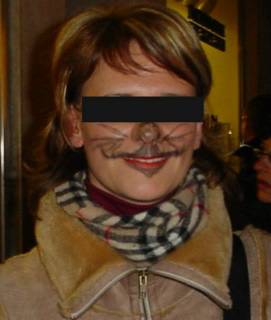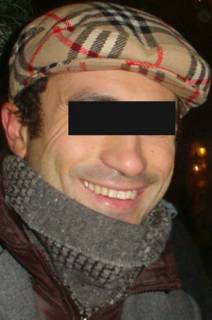A couple of clarifications seem to be in order regarding a post on my blog and the name of my blog itself. There I was blissfully posting away not recognizing that certain individuals reading my blog would not understand some of the allusions I have been making so wantonly. So, lest you think me a complete snob, allow me to first clarify the title of the said post, so unpretentiously titled "When I Had a Fulbright in Warszawa." This term, as you shall see, really belongs in quotes. So, I went ahead and made that essential typographical correction, which automatically turns anyone who uses it into an instant post-modernist, to the original post.
The phrase originates from an overheard conversation a friend of mine encountered at an internet kawiarnia:: cafe off of Krakowskie Przedmiescie near Warsaw's Old Town. Really he was the only one of us so-called "Fulbrighters" to actually hear this bombastic exchange put on so effortlessly by an ex-pat (of course!). But it did not matter that all of us were not able to witness this man make a complete ass out of himself, because his being witnessed by one of us was equivalent to his being witnessed by us all. In fact, his pompousness would affect all of us Varsovian Fulbrighters right down to the core of our very beings for the rest of our stay in Poland and beyond. As my friend so eloquently put it, "that dork kept talking and saying, 'When I was living in ...' " and each time he would make such a statement he would punctuate it by pronouncing the city or country with an exaggerated accent. (Sadly, my friend can no longer remember where this dork had traveled or lived -- but it was quite possibly somewhere in South America). That said/witnessed, the phrase "When I had a Fulbright in Warszawa" became a perfect moniker for our lived realities in good old Polska:: Poland, our little inside joke. A joke, I neglected to fill you in on, thereby embodying the very essence of the dork himself.
Moving right along, clarification # 2 is patiently waiting its turn to be read and understood. So long overdue is this clarification; it irks me that I didn't make it sooner. You may have been keeping tabs on my blog, and you may even have enjoyed it just a bit. Chances are, however, that if you lack familiarity with any sort of Slavic language, that there has been at least one point in your reading the title of my blog during which you strained your vocal chords attempting to pronounce it. All the while thinking, "what the hell does that mean, anyway?!?!?," while simultaneously hacking up tiny specks of spittle onto your computer screen attempting to sound out the syllables. Only to have to, then, wipe the screen squeaky clean before continuing to devour the words that I so narcissisticly offer up to you on a fairly consistent basis. Well, this too, I have to partially credit to my dear friend in the aforementioned clarification #1. You see, it is he who baptized me in the name of chrzan (hrzan):: horseradish as Chrzanka (hrzanka), my Polish punk name. It was, however, my idea to combine my Polish punk pseudonym, with the equally Polish greeting of "halo" (think Hello Kitty). Thereby, naming my blog. Ahhhh, finally, mystery solved and clarification achieved.
It's lewd multi-cultural pun fun time, boys & girls
chrzan beaver fever!

What on earth does a beaver have to do with chrzan:: horseradish?!?!?! I am as stumped as you are.
Making this serendipitous discovery reminded me of a picture I took of a food delivery van in the Czech Republic. Upon spotting the van I was initially shocked at its chosen logo:
hungry for some . . . ?
 See, in Polish "cipa" is downright explicit compared to the connotations "beaver" elicits. Shocked I turned to my multi-Slavic-lingual friend (same friend from above), mouth wide open and said, "Can you BELIEVE that!" He quickly pointed out to my naive Slavic mind that "cipa" (food, if I recall correctly) in Czech is not the same as "cipa" (think kitty with a "p") in Polish.
See, in Polish "cipa" is downright explicit compared to the connotations "beaver" elicits. Shocked I turned to my multi-Slavic-lingual friend (same friend from above), mouth wide open and said, "Can you BELIEVE that!" He quickly pointed out to my naive Slavic mind that "cipa" (food, if I recall correctly) in Czech is not the same as "cipa" (think kitty with a "p") in Polish.
However, we all know both are just as rejuvenating, tasty, and satisfying!
I have been as busy as a beaver working on my crafts throughout the weekend. Okay, okay, so some projects were completed a while back, like the aforementioned scarf from a few posts past, and some were works in progress, but to me it doesn't matter because crafty is as crafty does, and I sure was crafty! So, as promised let me share with you the fruits o' my labor.
Remember those felt pins I mentioned in "Crafty Beaver?" Well, I finally got around to taking a picture of them. I am pretty proud of them. I have worn the circle one a few times already. However, ever since a friend of mine told me that the fish button one looked like a Girl Scout badge, I have not been as excited about wearing it. And, honestly, I haven't worn it yet. I have never been a Girl Scout and I don't exactly want to walk around looking like I am trying to relive a past that I never even got a chance to experience. But, then again, maybe I should wear it just to show off my pride in their inclusive and open-minded policy to include ALL girls in their organization regardless of their sexual orientation, race, ethnicity, etc (unlike, their intolerant and homophobic brother organization . . . yes, you know the one I am talking about).
Felt Pins

Moving on, I finally completed my first ribbed scarf! I more-or-less followed the instructions in Debbie Stoller's Stitch 'n Bitch. However, I opted for a skein of sportweight yarn (Lion Brand Yarn Co./Wool-Ease/Turquoise 148 - an acrylic wool blend) instead of the recommended bulky kind. I also used a pair of size 8 knitting needles instead of the recommended size 10. That would explain why it took me sooooooooo long to complete this so-called "beginner's basic".
Ribbed-for-Her-Pleasure Stretchy Scarf
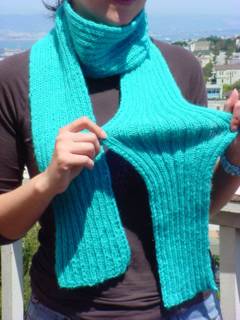
After I completed the project, I experimented a little with my remaining bits of yarn. Using the ever-simple garter stitch (purl, purl, purl, purling away) I coupled the turquoise sportweight yarn with a white multi worsted weight yarn made by the same company. I liked the end result; combined here as a duo alongside the scarf . . .
Turquoise Knit Scarf/Bracelet Combo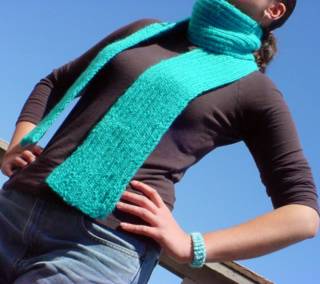
Nevertheless, I decided to play with it some more and I added a little accent to it. Using scraps of red felt and a random button from my container of random buttons I pieced together this double knit (not sure if that is the correct technical term, but I am going to use it anyway) funky flower bracelet:
Before:: Double Knit Bracelet
After:: Double Knit Bracelet Plus!
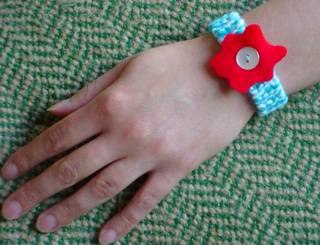
And finally . . .do you hear the drum roll . . . finally, I purchased my first ever sewing machine this last weekend at That Place That Sells Sewing Machines (relocated and renamed to The Sewing Machine Place). It is a fancy-shmancy computerized Baby Lock Crafter's Choice. I hardly know how to use the darn thing, but I spent most of my weekend trying to figure it out. No worries though, I'm scheduled to participate in a 3 hour long training class in early August, and until that time I will busy myself with the manual and very simple projects like my sock dolls. As you may know, I have a whole line of Polish Punk Princesses coming out (refer to the comments section in Crafty Beaver . . . but if you dare steal my idea I will rip your eyeballs out with my brand new seam ripper and then I'll sue your ass into oblivion! Got that!).
Ahhh, breathe Chrzanka, breathe . . . Oh yes, back to the sewing machine . . .
My Baby Lock Just Cares for Me ;-)

Regardless of the fact that I can't tell the difference between a topstitch and an overlock stitch, I still managed to produce this little drawstring Polka Power Dot Pouch. The picture is deceiving it is actually much smaller than it seems here about 5 inches high and 3 inches across. All in all, the perfect size to hold my glass marble charms. Yet, another work in progress.
Polka Power Dot Pouch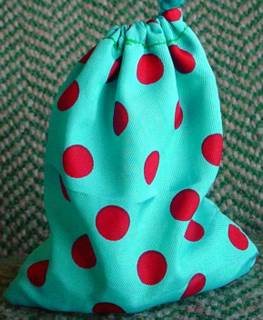
But, that my friends is for another time . . .
Craft out!
This is a segment I will be posting ever so often as a way of resurrecting and exploring the time I spent in Warszawa, Poland (2001-2002). This is something that I have actively avoided doing since my return to the States over 2 years ago. I am starting this project now because I find it a necessary mental exercise -- a way to help me process and digest my feelings about the entire mess and marvel that was Poland.
Warszawa flags
The stories, blurbs, items, pictures and any and all images posted will come from my Fulbright proposal/essay, my own journal entries, the e-mails sent to my family and friends, a variety of found and collected objects as well as pictures that I took. My observations will not be posted in any particular or chronological order because, like all memories and nostalgic recollections, reconstructions about the past do not occur in any orderly fashion. So, I won't force that artificial order on them either.
That said, allow me to begin at the beginning by posting select fragments from my personal essay - - part of the Fulbright application process.
~~~~~~~~~~~~~~~~~~~~~~
I am a Polish-American woman. Or, is it an American-Polish woman? The order of my hyphenated ethnic status may seem trivial to some, but the question of my "Polishness" weaves in and out of my life at a fairly constant pace leading me to ponder its meaning with necessary seriousness. My family emigrated from Poland to the United States in 1979, when I was three years old. As a result, my strongest connections to Poland are sensory. At a very young age, I learned how to unlatch the lock on the prickly green door of our small one bedroom Kosciuszko Street apartment. With my newly acquired skill, I would lead my younger sister on adventures to the cellar that began at the bottom of the stairwell. I remember a musty, stale cellar and the odor of stored coal. My mother worried as we involved ourselves in mischievous fun and youthful escapades. The rest of my memories of Poland are indistinct, colored by my family's retellings of pre-immigrant life and by timeworn black and white photographs.
Besides these memories, it is difficult for me to say what it is that makes me Polish other than I was born in Poland. I attained official United States citizenship in 1994, when I was a freshman at university. My connection to my Polish origins have been limited to family rituals, long distance phone calls to relatives still residing in Poland, attending Saturday Polish school, and taking part in the perfunctory Polish rituals. One of the most memorable traditions that has meaning to me is the Polish Christmas Celebration of Wigilia. This is a time when the bonds of the Polish community are felt through the sharing of stories, food, and oplatek (holy wafer). As newcomers to the United States, we were unaccustomed to and felt alienated from American behavior and society; celebrating Wigilia allowed us to maintain a sense of solidarity and identity in a new environment. Over the years, we have "Americanizied" our approach to Wigilia by tempering some of the religious undertones and dietary guidelines. However, we still celebrate the underlying essence of communal cohesion.
For a long time, my Polish identity was something that I wanted to hide. Poles in Chicago, especially newly arrived immigrants, were frequently taunted as being "stupid Polaks." Growing up it was something I learned to be embarrassed about. I took pride in people's appraisal of me as a Spaniard, Italian, or Grecian because it meant that I did not look and act Polish. However, being a first generation immigrant meant more than superficial adolescent frustrations surrounding peer acceptance. My ethnicity mattered to me but my immigrant status also located me within a specific social stratum of the "upwardly mobile" first generation white immigrant.
The immediacy of establishing stability and security for a family of four in a new country meant that my parents had to quickly gain a foothold in the States. At the time, they did not speak English and their social network was limited to my grandmother, who lived and worked in Chicago. With my grandmother's, help both of my parents found employment as janitors working the swing shift for the past twenty years in Chicago's high-rises. Occasionally, my mother would also take on "domki," that is, she would clean other people's houses on the side for extra income. During the week, exchanges with my parents were limited to a couple of hurried hours between pick up from school and their departure for work. It was only during the weekends when we were able to connect with the reduced frenetic trappings of domestic obligations and differing work schedules.
Our ultimate connections and tensions evolved around negotiating the American public educational system. It was a system that was bewildering to my parents with all of its liberal democratic trappings. After all, what did getting a "free" education mean when it was coupled with mediocre curricula, under funded resources, rundown buildings and concern for physical safety from local gangs? As immigrants, my parents guided and instructed me as best as they could with the linguistic obstacles of speaking a second language and their unawareness of how to participate effectively in my education. It was always the question of "what next" that puzzled us. This became excruciating evident when I approached graduation from high school. The process and politics of registering for standardized tests, researching higher education institutions, and applying for colleges were daunting. Learning to negotiate such an unfamiliar world was difficult, but ultimately proved rewarding.
As I mature and because of my experiences, I yearn to understand and relate to my Polishness on a more intimate level. Moreover, I seek to understand what it means to be a Polish woman in all of its contemporary permutations. After graduating from the Chicago public school system and after completing four years of university study, I have been drawn to the study of ethnicity, immigration, and gender identity across borders and within them. My identification as a first generation Polish immigrant woman growing up in Chicago and attending multiethnic schools has enhanced my own views of social issues. Moreover, it has guided my academic interests.
With hunger in our bellies, money in our pockets, and two hours to spend delighting our gastronomic senses we headed toward Old Krakow, the only Polish restaurant in San Francisco, for some down home cooking. I agree with the rest of the critics that dine at Old Krakow, located in SF's bizarre little West Portal neighborhood. The food is good -some dishes are even great!- but way too expensive for Polish food. So, if you are ever feel like consuming a Polish meal, are in the Bay Area, and don't feel like dishing out the $15.00 for the golabki. Head to the market instead and spend the same amount of many on the ingredients below and make enough golabki to feed a group of about four. Heck, even if you aren't in the Bay Area, go ahead and treat yourself. Actually, you'll probably get more bang for your buck since you'll be buying groceries that most likely will cost less than they would here.
Chrzanka presents a recipe for Polish Stuffed Cabbage (Golabki*)
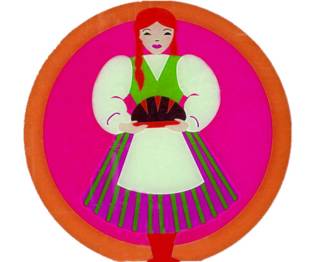
~~~~~~~~~~~~~~~~~~~~~~~~
*Pronounced - go whoa m b key.
Oh, the fun you can have with golabki! This Slavic delight can be enjoyed in a variety of ways. The stuffing (ground meat, sausage, mushrooms & rice ...) can be as diverse as the sauces in which the golabki bathe. In the culinary sense, the word "golabki" means stuffed cabbage, but in the everyday Polish sense, it can also mean little pigeons. I'm not sure why this is (something about the shape of the rolls perhaps?). I can assure you, though, that it has nothing to do with eating little pigeons.
- 1 lb. ground turkey (Any ground meat will do really. When I was a vegetarian, I used mashed up firm tofu. I betcha that faux vegan "meat" would work nicely, too.)
- 1/2 cup rice (more if you prefer more rice in the stuffing)
- 1-2 cups water
- 1 medium onion, diced
- 1-2 eggs (usually one is enough)
- salt and pepper to taste
- 1-2 tablespoons of flour
- Several dashes of marjoram (or Italian Seasoning)
- 1-2 can tomato paste (depending on how saucy you like it)
- 1 medium head savoy cabbage (savoy cabbage -the wrinkly kind- is best because it is easier to work with and easier/softer to eat, but the regular cabbage is OK too)
Rinse and core the cabbage and remove any bruised leaves. Put the entire cabbage in a large pot of water. Bring to a boil and simmer. I don't know how long you need to do this; I usually do it about 30-45 minutes from the boiling point. The idea is to soften the leaves so that they are easier to handle and eat. While the cabbage is boiling, steam the rice. When the cabbage is done CAREFULLY remove it from the pot. It will be HOT, HOT, HOT!! Rinse it in cold water. When it has cooled a little, remove the leaves one-by-one. As you get to the center, the leaves will get smaller and you won't be able to use them for golabki. You can either throw them away or save them for another recipe. You may want to devein the cabbage leaves by slicing off a portion of the main artery of the leaf.
Put ground meat, steamed rice, onions, egg(s), marjoram, salt and pepper in a large mixing bowl. Make sure the rice has cooled sufficiently before you start mixing. Mix the ingredients well.
Fill each cabbage leaf toward the bottom of the leaf with the stuffing mixture. I think a nice heaping tablespoon is usually enough, but that really depends on the size of your cabbage leaves and your appetite. Fold leaf to enclose the mixture. Do this by folding in the two sides of the leaf toward the center and rolling it up from the bottom up. Pack the golabki tightly side-by-side in a baking dish and pour a mixture of salt water over them. Bake uncovered in 350 degree oven until the leaves start to turn golden.
It's time to sauce it up! Golabki can be served sans sauce but they are usually served dressed up. Most often golabki are served in a tomato sauce but they can also be served in a variety of other sauces (e.g. cream sauce or mushroom sauce). It is your choice and I encourage you to experiment. Since I usually make my golabki with tomato sauce that is the recipe I will give you here.
Once the golabki turn golden is when you'll want to add a mixture of tomato paste, flour, water and seasonings (mix these -to your taste- before adding) to the baking dish. Continue to bake the golabki - this time covered- until the sauce thickens. You may want to make an extra batch of the sauce on the side, since sometimes the golabki absorb a good deal of the sauce. Smacznego!
On Central Avenue in Chicago there used to be a hardware and lumber store called the Crafty Beaver. It is probably still there. My family used to drive by it on the way to and from church on Sundays, to O'Hare Airport, or to my Great Aunt Dolly's house in the suburbs. I didn't realize the juvenile associations the store's name connoted until much later in my teen years. Although, I know better now, thinking about the store's name still makes me giggle.
So, in the spirit of the Crafty Beaver and all of its inspirational glory, I'd like to introduce you to a couple of crafty items of my own that I have been busying myself with these past few months. (Yes, I was just trying to find a way to mention the Crafty Beaver here.) You may have read about my interest in making sock dolls (mentioned in my profile). It is a craft that I have not yet perfected mainly because I seriously lack basic sewing skills, which will be remedied soon enough when I purchase my first sewing machine. Nonetheless, I would like to share with you my sock doll prototypes. Meet the girls!
Ready for their close up!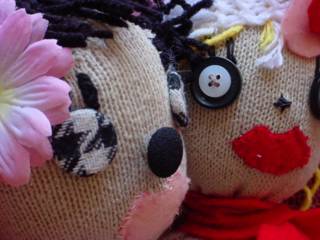
Well, what do you think? Aren't they as cute as can be? There will be more to come once I get my hands on that sewing machine. Any comments and suggestions on how I can improve my little chickies would be much appreciated and definitely taken into consideration even if not always honored.
More crafty handiwork to come soon... Just as soon as I take and upload the pictures. Currently, I'm working on a couple of hand knit scarves as well as some marble glass charms that I'll fashion into magnets, pins, and jewelry. Oh, and there are those felt pins... Hmmm, writing about all of this is making my palms itchy. I better go and knit a few rows on that scarf.
Spent last night at the Lush Lounge wishing my main amico farewell. He'll be traveling to Southeast Asia for a month, which will be an entire month spent without him. Sad for me, but well-deserved by him. Wishing you many wonderful adventures, yummy food, massages on the beach, and pure relaxation. Enjoy mio carino amico!
~~~~~~~~~~~~~~~~~~~~~~~~~~~~~~~
I have been told that my paternal grandmother, Babcia Zosia, who lives in the small northwestern Polish town of Wrzesnia has not been feeling well these days.
Map of Wrzesnia painted on the side of a building in the rynek (old town square)

So, before retiring to bed, I decided to give my Babcia a ring to cheer her up. Not an easy task, since my Babcia's Slavic blood runs thick with post-Communist pessimism and despair. Regardless of the daunting task, my guilty conscience got the best of me and I called her at 9:30 A.M. her time. She picked up the phone with a weak, "Halo." I asked her how she was doing and once she started to speak I realized there were no words of comfort that I could offer her. They would just be met with helpless resignation to her perceived fate. After all, what does one say to someone whose situation is hopeless?
Speaking with my grandmother reminded me of a passage from a book, Aliens & Anorexia by Chris Kraus, that I started reading a few days ago.
Kraus writes:
When you're young, you look at older women like they're ciphers. Ciphers that you'd rather not decode, because you know you might be looking at the future. Their defeats and compromises are so visible. You wonder if they notice that you're studying their faces as they speak: the sagging flesh around their mouths and foreheads, the heavy fragile eyelids, wondering could she be me? Vague apprehension of a girl believing that she'll beat the odds, although she knows full well the woman that she sees was also once a girl... Not wanting, then, to think too much about how anybody gets from here to there; or more precisely, not wanting to imagine the events that might deform a person over twenty years....
Or, even a lifetime...


